–
中華國術秘傳 少林護山子門羅漢拳圖影
SECRET TEACHINGS OF CHINESE MARTIAL ARTS: SHAOLIN MOUNTAIN-GUARDING MIDNIGHT STYLE LUOHAN BOXING ILLUSTRATED
朱霞天
by Zhu Xiatian
[published Oct, 1930]
[translation by Paul Brennan, March, 2021]
–
引言
INTRODUCTION
余自垂髫致力拳藝,迄已二十餘年,此二十餘年中曾北走幽燕,西游甘陝,湖海一騎,挾以自豪者,子門羅漢拳亦其一也。此拳余受自第三業師,師法號企岳,系出少林,傳少林當代邁殊大師衣缽,功精內外,余北面執禮躬承提命者凡六年,惜限於天資,未窺堂奧,祇涉蹊徑面已。惟師愛余甚,末後乃以此拳授余,並謂余曰,此乃少林護山法拳,舍達摩點穴拳外,當推翹楚。少林拳藝震天下,然率皆混稱曰少林拳、少林棒,而不知少林系中尚有三乘十二門也。子丑寅卯四門為上乘,辰已午未四門為中乘,申酉戌亥四門為下乘,上乘恃以護山,向不外傳,外傳者僅中乘,而又以午門為多,至上乘中之子門拳,不但拳不外傳,並名亦不使外溢。此拳虎視龍驤,左顧右盼,有雷電飛騰、風雲叱咤之勢,研而精之,當者辟易,今以子天資渾厚、氣度寬大,用以相授,當不致挾以行不逞也,爾其珍之!余受而習之,又將六年,雖未精進,尚多心得。值茲國府提倡國術之際,國術運用,已納於正當途徑,爰為公開之貢獻,演而出之,以供同好,此舉或不致有忤師意也。不然,終恐此大好國術,因年湮代久,漸成廣陵散耳,
霞天謹識
I have devoted myself to boxing arts ever since childhood, more than twenty years. Over the course of these twenty years, I traveled north beyond Hebei west beyond Shaanxi, south and east to the coasts, and to the lakes everywhere in between. Of all that I have learned in my travels, Midnight Style Luohan Boxing is the best.
I learned this boxing set from my third teacher, the monk Qi Yue [“gazes up at the peak”], who himself learned the Shaolin art from the great master Mai Shu [“walks with distinction”], mastering both the internal and external skills. I had so far applied myself faithfully to the northern arts for six years, but due to my lack of talent, I never really managed to get a proper glimpse of their profundities, only scratching the surface. However, my teacher liked me, and so he decided in the end to go ahead and teach me this boxing set. He told me: “This art is known as Shaolin Mountain-Guarding Boxing. Going beyond Damo’s method of striking acupoints, it will take you the rest of the way into mastery.”
The Shaolin boxing art has shaken the world, and yet although everyone talks of Shaolin Boxing and Shaolin Staff, nobody knows about Shaolin’s “three levels”, divided into the “twelve styles”. The four styles of Midnight, Post-Midnight, Pre-Dawn, and Dawn are the higher level. The four styles of Post-Dawn, Pre-Noon, Noon, and Post-Noon are the middle level. The four styles of Pre-Dusk, Dusk, Post-Dusk, and Pre-Midnight are the lower level. At the highest level is the Mountain-Guarding set, which is not taught to laymen. Laymen may be taught no higher than the middle level, most commonly the Noon Style. The Midnight Style within the higher level is not only not taught to laymen, it is not even shown to them.
This set turns in all directions with a dragon’s proud poise and a tiger’s angry glare. It has the energy of a surging storm or a roaring wind. If you study it and become skillful at it, then when you feel pressed to retreat, you can use it to activate your abilities and amplify your bearing. This set ought to be taught, not hidden away as a treasure for oneself. I learned it and have been practicing it for the last six years. Although I have still not mastered it, I have gained much from the experience.
Now that the government is promoting Chinese martial arts, these arts have been given a better chance at survival. I have therefore decided to publish a book about this boxing set in order to share it with all those who may be interested. I only hope this action will not go against my teacher’s wishes. I simply fear that if I do not share this wonderful martial art, it will gradually slip into oblivion and become as extinct as the notorious Guangling Melody.
- sincerely written by Zhu Xiatian
–

演著者朱霞天先生肖影
Portrait of the author, Zhu Xiatian
–
預備式說明
PREPARATION POSTURE
預備式為各路拳藝不可少之開明宗旨,而本拳尤加注意,宜立正身軀,並齊雙足,下垂兩股閉口凝神,藏氣蓄勢,鎭靜張事,如面敵然,猶兵法所謂:「守如處女,出如兎脫」者也。蓋鎭靜旣慣,一旦遇敵,能察其來勢,可審愼應付,不致手慌足亂矣。
A posture of preparation is an indispensable moment in every boxing set for focusing on key principles. While in this position in this particular set, give attention to these requirements: body straight, feet together, arms hanging down beside your thighs, mouth closed and spirit concentrated, energy stored away and power building up, and a state of calm is established that will be maintained throughout the set. When facing an opponent, apply this principle from the Art of War [chapter 11]: “Begin guardedly like a shy girl until he opens his gates, then invade like a rabbit diving into one of its bolt-holes.” Make a habit of being calm, and then whenever you encounter an opponent, you will be able to examine his incoming force and respond appropriately, without your hands ending up in a state of confusion and your feet in disarray. See photo 1:
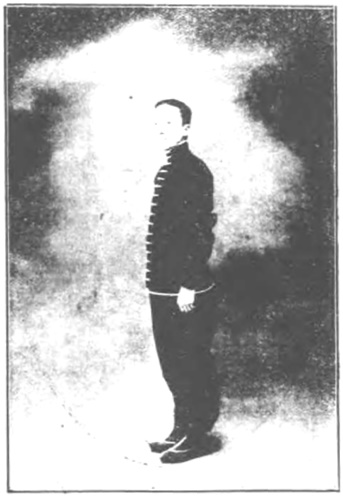
起點式說明(一)
BEGINNING POSITION – Part 1
預備得法,則神凝氣充,可以演起點矣。本式由上式先將左足提起,向前踏出半步,足尖點地,身向下坐成左吊馬步,同時雙掌直舉而起,從腰間向前伸直高可平胸,然後再左右分開,以應下式。
Now that you are in a state of readiness, your spirit is concentrated and your energy is full, and so you can perform the beginning position. Your left foot lifts and goes forward a half step to make a left hanging-horse stance, touching down with the toes, as your hands go forward and upward until at chest level, then spread apart so that your left hand stays forward and your right hand draws back. See photo 2:

起點式說明(二)
BEGINNING POSITION – Part 2
本式由上式將雙掌翻起,略灣肘腕,從肩前推出,右掌成拳,左掌搭在右拳上,成抱月形,如說一聲請了,為表示本拳精神無畏,態度雍容之意。本式因動作複雜,故以一二兩圖表明之。往後有複雜處亦如之,或以兩圖三圖不一定,請學者注意。
Your palms then turn over to be facing upward, your elbows bending, and push out forward from your shoulders with your right palm becoming a fist and your left palm touching on top of your right fist, making a shape of “embracing the moon”, though it is more commonly described simply as a “salute”. This action expresses a fearless martial spirit and shows a dignified poise. The movements of the beginning position are complex enough that it requires two photos. Be aware that later complex movements are likewise broken down into multiple photos. See photo 3:

第一手說明
MOVEMENT 1
本式由上式將右拳成掌,直起向右掠去,同時左掌亦直起向左掠去,用以分開敵人兩手,下部仍作左吊馬步,無變化,以應下手。
Your right fist becomes a palm, rises up, and sweeps aside to the right, as your left palm also sweeps aside to the left, your hands spreading apart the opponent’s hands in preparation for the following technique, your lower body remaining in a left hanging-horse stance. See photo 4:

第二手說明
MOVEMENT 2
本式由上式將左足踏實,右足彈直,身軀挺起,左掌成拳,收攏靠腰,右掌成拳收攏從腰間打出,虎口朝天,攻入敵人心口,以應下式。
Your left foot advances, the weight going onto it, your right leg straightening, your body rising, as your left palm becomes a fist, pulling back to your waist, and your right palm becomes a fist and strikes out from your waist to attack the opponent’s solar plexus, the tiger’s mouth facing upward. See photo 5:

第三手說明
MOVEMENT 3
本式由上式將右足提起,身軀略向下坐,出左拳成掌,右拳亦成掌,兩掌相並,對膝蓋上拍下,同時膝蓋向上騰起,攻敵人撞來頭顱,以應下式。
Your left fist extends next to your right fist, then both fists become palms and slap down on top of your right knee as it springs upward to attack the opponent’s head. See photo 6:

第四手說明
MOVEMENT 4
本式由上式將右足踏出,成右弓步,兩掌成拳,先向左右略分,成環形,收攏,拳頂相對,虎口朝下,勢成夾擊攻敵人兩陽,以應下式。
Then your right foot steps forward to make a right bow stance as your palms become fists, slightly spread apart to the sides, and arc forward, coming toward each other, the knuckles of each hand turned inward to be pointing toward each other, the tiger’s mouths facing downward, performing a pincering attack to the opponent’s temples. See photo 7:

第五手說明
MOVEMENT 5
本式由上式將左拳成掌,搭住右臂肘灣,同時右臂卽向下揮轉,望上打出,拳背向外,攻敵人頂門,以應下式。
Then your left fist becomes a palm and touches the inside bend of your right elbow as your right fist sinks down, rolls over, and strikes out upward to attack the opponent’s face, the back of the fist facing outward. See photo 8:

第六手說明(一)
MOVEMENT 6.1
本式由上式將左足提起,略向左面踏出,同時左掌離開右臂肘灣,向左面掠去敵人來手,准備接應下式。
Your left foot lifts and steps out to the left to make a left hanging-horse stance, as your left palm leaves your right elbow and moves across to the left to sweep aside the opponent’s incoming hand in preparation for the following technique. See photo 9:
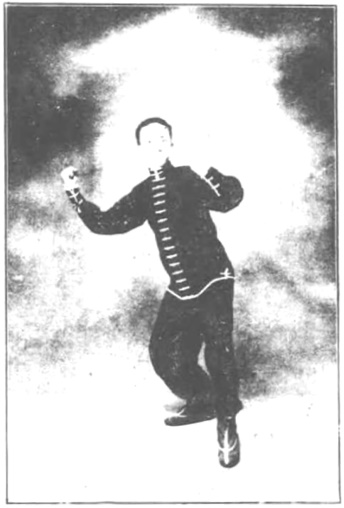
第六手說明(二)
MOVEMENT 6.2
本式由上式將左膝挺出,右足彈直,成左弓步,同時左掌成拳,收攏靠腰,右拳下沉,從腰間轉出,猛向上擊,攻左面敵人下腭,以應下式。
Your left knee bends and your right leg straightens, making a left bow stance, as your left palm becomes a fist and withdraws to your waist, your right fist sinking down and then going out in arc from your waist, fiercely striking upward to attack the opponent’s chin. See photo 10:

第七手說明(一)
MOVEMENT 7.1
本式由上式將右足提起,向右踏出,身軀略向左傾,左拳仍護腰間,右拳成掌,向右面掠去敵人來手,准備接應下式。
Your right foot lifts and steps out to the right, your body slightly leaning to the left, your left fist remaining at your waist, as your right fist becomes a palm and goes across to the right to sweep aside the opponent’s incoming hand. See photo 11:

第七手說明(二)
MOVEMENT 7.2
本式由上式將右膝挺出,步向右移,左足彈直,成右弓步。右掌成拳,收攏靠腰。左拳從腰間轉出,猛向上擊,攻右面敵人下顎,以應下式。
Your right foot shifts to the right and the knee bends to make a right bow stance, your left leg straightening, as your right palm becomes a fist, withdrawing to your waist, and your left fist arcs out from your waist, fiercely striking upward to attack the opponent’s chin. See photo 12:

第八手說明(一)
MOVEMENT 8.1
本式由上式將左足提起,向右踢出,成鏟步,身軀略向下坐,注重心於右腿,准備向右轉去,接應下式。
With your hands maintaining their position, your left foot lifts and kicks out to the right with a shoveling step, your body sitting onto your right leg. See photo 13:

第八手說明(二)
MOVEMENT 8.2
本式由上式將全軀疾然向左轉去,反正身軀,踏定兩足,略成左弓步,上部向左傾,同時左拳成掌,搭住右臂肘灣,右拳向左伸出,准備接應下式。
Your body quickly turns around to the left and your left foot comes down to the left to make what is almost a left bow stance, your right foot touching down with the toes, your upper body leaning to the left, as your right fist extends across to the left, your left fist becoming a palm and going to the inside bend of your right elbow. See photo 14:

第八手說明(三)
MOVEMENT 8.3
本式由上式將上部向右送,挺出右膝蓋,成右弓步,同時將右拳向上揮去,攻敵人面門,以應下式。
Your body turns to the right, your right foot advancing, your right knee bending to make a right bow stance, as your right fist goes upward and swings out to attack the opponent’s face. See photo 15:

第九手說明(一)
MOVEMENT 9.1
本式由上式將身軀向左側轉,左足畧提起足尖䠄地,左掌離開右臂肘灣,向面門掠過,削去敵人來手,同時運用全勁於右拳,准備接應下式。
Your body turns to the left, your left foot lifting and stepping out to the left to make a left hanging-horse stance, touching down with the toes, as your left palm leaves your right elbow and moves across to the left to sweep aside the opponent’s incoming hand, focusing power in your right fist and right leg in preparation for the following technique. See photo 16:

第九手說明(二)
MOVEMENT 9.2
本式由上式將身軀向左轉正,挺出左膝蓋,成左弓步,同時將右拳從耳旁擊出,左掌急忙搭住右臂,攻敵人上部,以應下式。
Your body turns to the left, your left knee bending to make a left bow stance, as your right fist strikes out from beside your ear to attack the opponent’s upper area, your left palm connecting with your right upper arm. See photo 17:
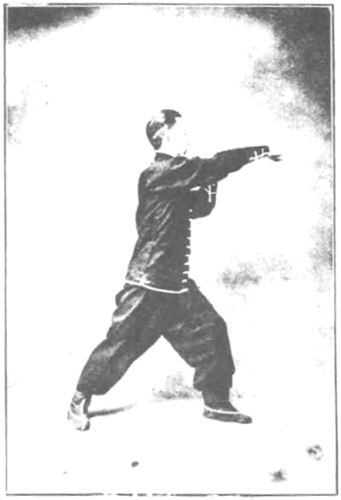
第十手說明
MOVEMENT 10
本式由上式將右足提起,反轉身軀,向右踏定,成右弓步,同時左掌離開右臂,向前掠起,右拳先化掌,接着同左掌再成拳,作捉住敵人手腕,强轉身軀,將敵人相後摔;此式動作時,有電摯風馳之勢,學者宜善體之,以應下式。
Your right foot lifts and steps forward to make a right bow stance, your body turning to the left, as your left palm comes away from your right arm and sweeps upward in front of you, your right first becoming a palm and moving along with your left palm, then again becoming a fist, grabbing the opponent’s wrist, while the strong turning of your body is used to throw him backwards. This movement is shocking as lighting and fast as the wind. Strive to embody these qualities. See photo 18:
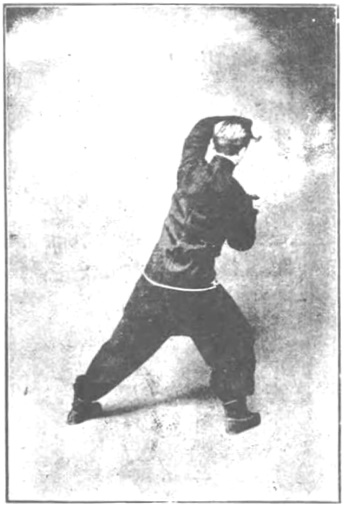
第十一手說明
MOVEMENT 11
本式由上式將右拳收攏近乳前,肘向右側鑽出,同時左拳成掌,收下搭住右拳,用力送肘,攻入敵人心口,以應下式。
Your right fist withdraws near your chest as your left fist becomes a palm and lowers onto your right fist, then your right elbow forcefully pokes out to the right to attack the opponent’s solar plexus. See photo 19:

第十二手說明(一)
MOVEMENT 12.1
本式由上式將身軀向左側轉,下部略成平馬步,同時左掌向胸前掠過,靠住左腰,右拳提開,準備接應下式。
Your body turns to the left, your legs almost making a horse stance, as your left palm sweeps across in front of your chest until at the left side of your waist, your right fist lifting to the side. See photo 20:

第十二手說明(二)
MOVEMENT 12.2
本式由上式將身軀向右轉正,提起右足,向右踢出,成鏟步,同時右拳揮向左面腰間,給左掌抱住,准備接應下式。
Your right foot lifts and kicks out to the right with a shoveling step, as your right fist swings across to the left side of your waist to be wrapped over by your left palm. See photo 21:

第十二手說明(三)
MOVEMENT 12.3
本式由上式將右足踏定,成右弓步;右拳成爪,左掌作瓢形,成拉弓式拉開,攻敵人面部,以應下式。
Your right foot comes down to make a right bow stance as your right fist becomes a claw, your left palm make a ladle shape, and your hands pull apart as though drawing a bow, your right hand going out to attack the opponent’s face. See photo 22:

第十三手說明(一)
MOVEMENT 13.1
本式由上式將左足提起,側轉身軀,向右側踢出,成鏟步,上部隨之轉向右去,注重心於右爪及右下部,准備接應下式。
With your hands maintaining their position, your left foot lifts and kicks out to the right with a shoveling step, your body turning to the right, the weight going onto your right leg. See photo 23:

第十三手說明(二)
MOVEMENT 13.2
本式由上式疾轉身軀,將左足向左踏定,略成左弓步,右足尖䠄地,同時右爪握緊成拳,向下沉,虎口朝天,右掌亦成拳,虎口朝前,准備接應下式。
Your body quickly turns around to the left and your left foot comes down to the left to make what is almost a left bow stance, your right foot touching down with the toes, your upper body leaning to the left, as your right claw becomes a fist and sinks down, the tiger’s mouth facing upward, your left palm also becoming a fist, the tiger’s mouth facing forward. See photo 24:

第十三手說明(三)
MOVEMENT 13.3
本式由上式側轉身軀,向左進,同時踏定後右足,成右弓步,兩拳從小胸前轉,出向上,前後並進,奮擊敵人上中兩部,以應下式。
Your body turns to the right, your right foot advancing to make a right bow stance, as your fists roll over, going upward from your belly and forward to the right, advancing in unison with your right fist more forward and your left fist behind it, vigorously attacking the opponent’s upper area and middle area. See photo 25:
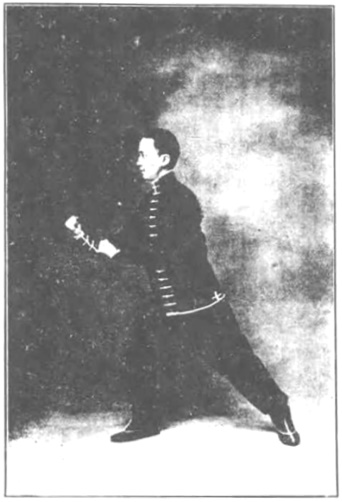
第十四手說明(一)
MOVEMENT 14.1
本式由上式轉正身軀,同時左拳成掌,向左面掠去,注重心於右拳及右下部,准備接應下式。
Your body turns to the left as your left fist becomes a palm and moves across to the left to sweep aside the opponent’s incoming hand, focusing power in your right fist and right leg in preparation in preparation for the following technique. See photo 26:
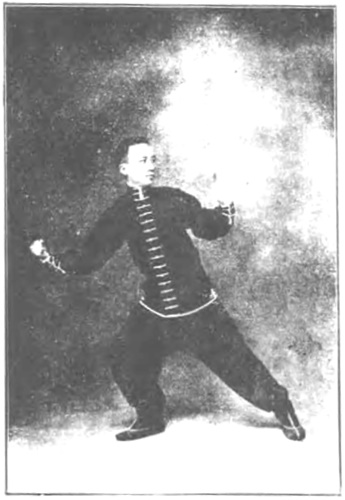
第十四手說明(二)
MOVEMENT 14.2
本式由上式側轉身軀,向左進,成左弓步,同時將左掌成拳,收攏靠腰,右拳向左吐出,攻敵人上部,以應下式。
Your body turns to the left, your left foot advancing to make a left bow stance, as your left palm becomes a fist, pulling back to your waist, and your right fist shoots out to the left to attack the opponent’s upper area. See photo 27:
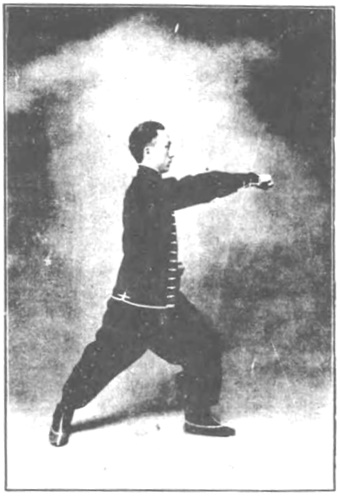
第十五手說明
MOVEMENT 15
本式由上式將右足提起,膝蓋向上騰,左拳伸出,並右拳同時俱化掌,向膝蓋上拍下,攻敵人撞來頭顱,以應下式。
Your left fist extends next to your right fist, then both fists become palms and slap down on top of your right knee as it springs upward to attack the opponent’s head. See photo 28:

第十六手說明
MOVEMENT 16
本式由上式將右足向前踏定,成右弓步,兩掌成拳,向左右略分,成環形,收攏,拳頂相對,虎口朝下,夾擊敵人兩陽,以應下式。
Then your right foot steps forward to make a right bow stance as your palms become fists, slightly spread apart to the sides, and arc forward, coming toward each other, the knuckles of each hand turned inward to be pointing toward each other, the tiger’s mouths facing downward, performing a pincering attack to the opponent’s temples. See photo 29:

第十七手說明
MOVEMENT 17
本式由上式將左拳成掌,搭住右臂肘灣,同時右拳向下沉,揮轉望上打出,拳背朝外,攻敵人面門,以應下式。
Then your left fist becomes a palm and touches the inside bend of your right elbow as your right fist sinks down, rolls over, and strikes out upward to attack the opponent’s face, the back of the fist facing outward. See photo 30:

第十八手說明(一)
MOVEMENT 18.1
本式由上式將左足略提起,向左踏出,作左吊馬步,同時右掌離開右臂肘灣,向面前掠去敵人來手,以應下式。
Your left foot lifts and steps out to the left to make a left hanging-horse stance, as your left palm leaves your right elbow and moves across to the left to sweep aside the opponent’s incoming hand in preparation for the following technique. See photo 31:
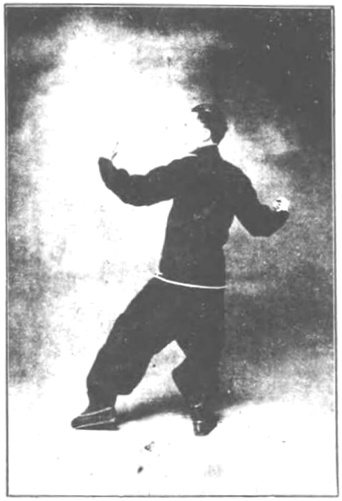
第十八手說明(二)
MOVEMENT 18.2
本式由上式將左足踏定,右足彈直身軀提起,左掌成拳,收攏靠腰,右拳略下沉,向腰間轉出,猛擊敵人上部,拳背朝天,以應下式終點。
Your left foot comes down forward, your right leg straightening, your body rising up, as your left palm becomes a fist, pulling back to your waist, and your right fist slightly sinks down and goes out from your waist to fiercely attack the opponent’s upper area, the forearm rotated so that the back of the fist is facing upward. See photo 32:

終點式說明(一)
FINISHING POSITION – Part 1
本式由上式將左拳吐出,並齊右拳,同時俱化為掌,左右分開,以應下式。
Your left fist shoots out next to your right fist, then both fists become palms and spread apart so that your left hand stays forward and your right hand draws back as you sit back onto your right leg. See photo 33:

終點式說明(二)
FINISHING POSITION – Part 2
本式由上式將雙掌翻起,略灣肘腕,從肩前左右推出,右掌成拳,左掌搭在右拳上,成抱月形,又如起點式。第二圖上說一聲請了之意,作收束終點,以示本拳始終抑讓雍容。
Your palms then turn over to be facing upward, your elbows bending, and push out forward from your shoulders with your right palm becoming a fist and your left palm touching on top of your right fist, making a shape of “embracing the moon”, the same as the salute in Part 2 of the beginning position, showing that this set has the same dignified poise from beginning to end. See photo 34:

反原式
RETURNING TO YOUR ORIGINAL POSITION
本式由上式將身軀抬起,左足收攏,並齊立正同時兩臂下沉腰間,右拳亦代為掌,兩掌俱收搭腿上,作反歸本原。如欲重演,可接應上列起點式,便又成全局矣。
Your body rises up, your left foot withdrawing to stand next to your right foot, as your arms sink beside your waist, your right fist also becoming a palm, your palms facing your thighs, restoring you to your original position. If you wish to repeat the sequence, you can easily go right back into the beginning posture and perform the entire set again. See photo 35:

– – –
[Included below is a chapter from Jin Tisheng’s Secrets of Shaolin Internal Training (1940).]
練功與修養
TRAINING & CULTIVATION
練習武功之本旨。實在于煆煉身體。使之堅實康强。亦所以防蟲獸盜賊之患。非救人以好勇鬪狠為事也。故涵虛禪師有學習武術。尚德不尚力之語。夫至德所及。金石可開。豚魚能格。初不必借重武力。而始可使人折服也。故學習武事之人。對于道德之修養。亦為最重要之事。若不講道德。專事武功。雖未始不足以屈人于一時。然終不能使人永久佩服。蓋力足以屈人之身。而不能人之心也。每見武術功深之人。謙恭有禮。和藹可親。縱有人辱之于通衢。擊之于廣座。彼亦能忍受。韜晦功深。不肯輕舉妄動以至人于傷害也。蓋彼功夫旣精。若不如此。則舉手投足間。皆足以殺人。殺人為喪德之事。故不為也。惟彼略得一二手勢。粗知武功皮毛者。則粗心浮氣。揚手擲足。欲自顯其能為。尤為小事。甚則好勇鬪狠。動輒與人揮拳。勝亦無益。敗或殘身。且偶然之勝。亦不可終恃。結果必有勝我之人。此俗語所謂有丈一還有丈二者是也。此等擧動。實為自殺之道。去學武之本旨遠矣。以項羽之勇。而終敗于烏江。非武功之不逮。德不及也。故德性之修養。宜與武功同時並進。而品性優良之人習武事。則保身遠禍。性情殘暴之人習武事。則惹禍招非。此一定不易之理也。昔聞有投身少林學習武事者。主僧默察其人。趾高氣揚。傲慢特甚。與之語。尚豪夾。乃留諸寺中。初不敎以武技。惟每日命之入山採樵。日必若干束。雖風雨霜雪。亦不能間斷。不滿其數。則繼之以夜。稍忤意志。鞭撻立至。其人歷盡折磨。惟以欲得其技。含忍待之。經三年之久。驕氣消磨殆盡。主僧始授以技。此非故欲折磨之。實以其驕矜之氣太重。學得武功。深恐其在外肇禍。累及少林名譽也。顧此乃他人消磨之。非自己修養也。少林十條戒約之中。亦有戒殺及好勇鬪狠一條。此又可見少林武術。對于德性之修養。亦甚注意也。凡武術精深之人。于自身之修養外。對于收徒一事。亦須特加注意。務必擇性情優良之人。始傳以衣鉢。若性情强暴者。儘可揮諸門外。寗使所學失傳。不可將就。因此輩學得武藝之後。好勇鬪狠。固足害人。甚且流為盜賊。殺人越貨。尤足為師門之累。是不可不三注意也。旣收徒之後。平日除督促其練習功夫之外。對於德性之修養。亦宜兼顧。如此薰陶。則其人將來學成必不至越禮踰分矣。
The purpose of practicing martial arts is primarily to strengthen the body to make it healthier, secondarily to defend oneself against threats from attackers, and not to get into fights unless you are rescuing someone from peril. As the Zen master Han Xu [“containing emptiness”] said: “When practicing martial arts, value virtue rather than force, defense rather than attack. Defense involves stillness, and in stillness lies the opportunity to survive. Attack involves movement, and in movement lies an opportunity to get killed.” Achieving virtue, you have a defensive weapon, like the spines of a puffer fish. You no longer have to overcome an opponent with force, you instead have a means of dissuading him.
The most important thing for martial artists to cultivate is morality. If you ignore the moral aspect and focus only on the martial aspect, this will be adequate to defeat people, but you will fail to win them over afterward, subduing their bodies but losing their hearts. Notice that a highly skilled martial artist is always polite and friendly. Even when being insulted or humiliated by someone, he is able to endure it and remain calm, unwilling to lash out and end up injuring the person. This shows his mastery of his art. Without such restraint, any action he takes with hand or foot is capable of killing, which would only turn the situation into a tragedy.
A few movements are all it takes to reveal a superficial martial skill and a rash temperament. One who throws out his hands and feet in an attempt to show off has little to show. He is merely someone who loves getting into fights and will fling his fists at anyone. Even in victory, he will still not have won, and in defeat, he is bound to have been injured. He cannot even rely on winning by accident, and so he is bound to lose. There is a common saying: “For every tall man, there’s an even taller man.” [i.e. “There’s always somebody better.”] Such actions are suicidal and far from the original purpose of learning martial arts. The boldness of Xiang Yu ultimately failed him at Wu River. Without learning to restrain one’s martial skill, virtue will not be achieved. Therefore the cultivation of virtue has to be developed alongside martial skill. A martial artist who possesses moral character will be able to protect himself against misfortune, whereas a martial artist with a brutal disposition will invite disaster. This is an unchanging principle.
In the past, whenever someone came to the Shaolin Temple to learn martial arts, the head monk would quietly observe the level of the visitor’s arrogance, then tell him bluntly to go wait in the temple. In the beginning of his training, there was no teaching of martial skills, instead he was commanded every day to go into the hills to collect firewood, no days off, no matter the weather, even if wind was howling, rain was pouring, or snow was burying the landscape. If he came back with too little, he was sent back out to work during the night. If he ever refused, he was whipped until he complied. By suffering such hardship, he was taught the endurance he would need to learn martial skills. After three long years, once his ego had been worn down, the head monk would then begin to teach him.
He was not treated this way because the monk wished to torture him, but to diminish his arrogance. If an arrogant person was taught the temple’s martial skills, he would likely cause trouble after leaving the temple and ruin the good name of Shaolin. Such behavior would show the art to be about destroying others rather than cultivating the self. Among the rules of Shaolin are “no killing” and “no starting fights”. This shows that the Shaolin martial training also gives great attention to the cultivation of virtue.
Beyond self-cultivation, masters must give special attention to the accepting of students, teaching only those of good temperament. Violent people can only be waved away from the door and taught nothing of the art at all. After learning martial skills, if a person loves using what he has learned to get into fights with and hurt people, he is liable to go on to become a thief or a murderer, tarnishing the teachings forever. This is why a person’s temperament has to be given repeated attention. After accepting a student, in addition to encouraging him to practice his skills every day, equal emphasis needs to be given to the cultivation of virtue. This kind of wholesome influence will ensure that he does behave improperly after he has completed his studies.
–
–
–
